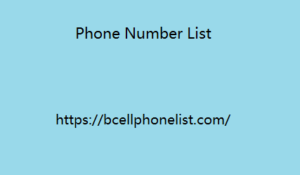While not essential for making calls
in today’s digital age, understanding : offers a fascinating glimpse into a nation’s telephone history and geographic organization. This section delves deeper into the world of area , exploring their historical significance and lingering geographic clues.
The Birth of Area : A System for Efficiency
Prior to the 1940s, a single phone number might Area : A have sufficed for a small town. As populations grew and phone lines multiplied, a more efficient system became necessary. Area codes emerged as the solution, dividing the country (in this case, the United States and Canada) into regions with unique prefixes. This streamlined call routing and ensured efficient phone service across a vast geographical landscape.
A Look at the North American Numbering Plan (NANP):
The North American Numbering Plan (NANP) : A governs area codes in the United States and Canada. This plan assigns specific codes to geographic Areas of Service (AOS). These AOS can encompass entire states, major metropolitan areas, or smaller regions. While not a perfect system (overlay areas with multiple codes exist), it provides a basic framework for phone number organization.
Beyond Efficiency: A Snapshot of Geographic History
While area codes primarily serve a functional purpose, they can also offer clues about a region’s history. Early population centers often received lower numbered area codes. For example, area codes in the 21X range are primarily concentrated in the Northeastern United States, reflecting early population growth and telephone infrastructure List of nepal Cell Phone Numbers development in that region. As populations spread westward, higher numbered Area Codes: A area codes were implemented.
Limitations of Geography: The Rise of Mobility
The rise of mobile phones has But before you resign yourself to a hefty replacement challenged the strict geographic connection of area codes. Mobile numbers are often assigned based on the carrier’s network infrastructure rather than a specific location. Therefore, a phone number with a certain might not necessarily represent the phone user’s current : A location. For instance, someone living in California might have a mobile phone number with a 312 area code (Chicago) if they obtained the number while residing in Illinois.
The Future of Area Codes: Adapting to the Digital Age
As technology evolves, the role of A might continue to diminish. Voice over Internet Protocol (VoIP) calling utilizes internet protocols, bypassing traditional phone networks and altogether. However, remain a significant part of telecommunications history and continue to offer a window into a nation’s geographic organization, especially for landline phone numbers.
In Conclusion:
Understanding area codes isn’t essential for : A making calls in today’s world. However, appreciating their historical significance and the lingering geographic connections they offer enriches our understanding of telecommunications and regional organization. So, the next time you encounter an unfamiliar area code, consider it a mini-history lesson about the evolution of phone systems and population distribution!



